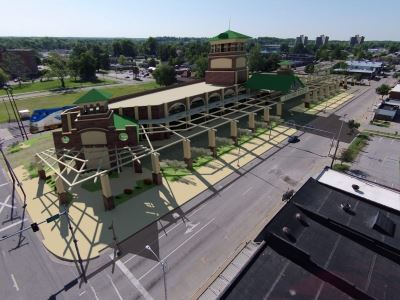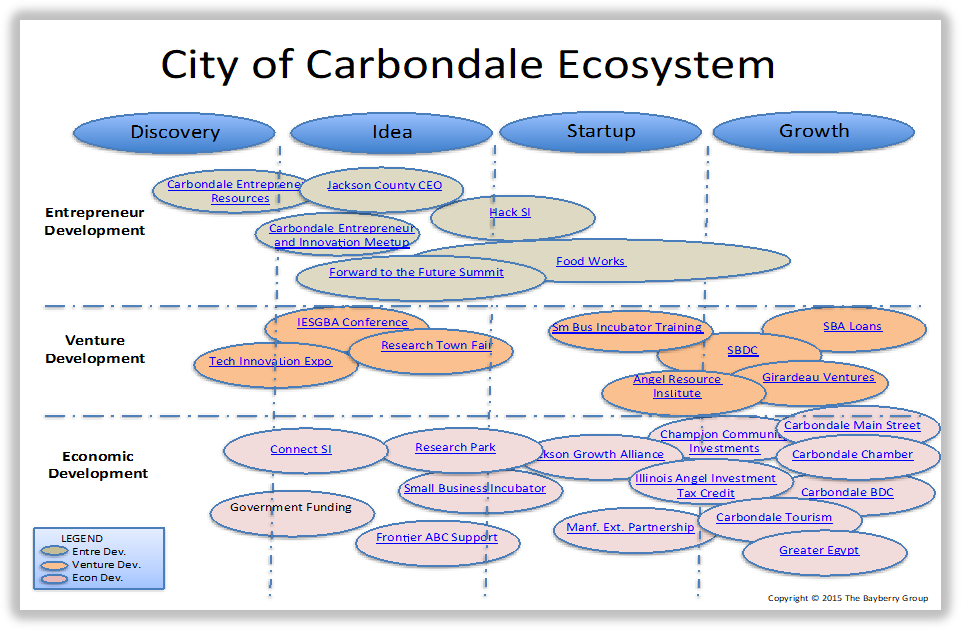
Carbondale Coworking – TOD
A coworking space is a place where individuals can work independently in a shared space, using shared resources. Typically, it is place that young entrepreneurs, freelance professionals, remote workers, and startup and small businesses will utilize to either get their businesses started or as a next step from working from home. Those who make use of a coworking space are often those who need a more professional space and seek a community with a collaborative spirit.
In this particular engagement, the final business plan sought to integrate the coworking site as part of the South Illinois Multi-Modal Transportation Center (local bus service and Amtrak) in the city center. iNeighborhoods also performed market research of similar rural city-university pairs, assess the current state of the entrepreneurial ecosystem, describe the economic value proposition and create a master business plan spread sheet that would allow the coworking -TOD site to grow over a period of ten years as the coworking business evolved through various stages of development.
That said, the Carbondale Coworking – TOD model could be used as a standalone in other rural communities or as part of a Multi-Modal Transportation Center or TOD. This particular station will also become the future home of the Carbondale Grey Hound Bus and Amtrak Station.
Market Research
Within the focus groups, we heard many reasons for interest in coworking and the need for using workspaces outside the home or the regular office location. The most compelling use cases from a business model perspective (i.e. use cases that would support regular recurring revenue) are individual business owners looking for office space, remote workers, and regional service providers who need a “home base” for meeting with clients or hosting meetings.
About one third of those surveyed (29%) said they would “definitely” or “probably” join a coworking space. This expression of interest should be understood at a high level. There are many variables in terms of both cost and amenities that affect likelihood to become a member at a coworking space (much more detail in the final report).
Entrepreneurial Ecosystem
Each ecosystem graphic has several ecosystem elements that are shown as ovals containing the name of each program, activity or asset. Elements are positioned along a venture evolution time-line showing when an entrepreneur might use that ecosystem element. The time-line has four phases of evolution-Discovery, Idea, Startup, and Growth.
Ecosystem elements are also categorized as Entrepreneur Development, Venture Development or Economic Development. Entrepreneur Development elements (tan background) are more human development in nature. They are things like meet-ups, education, events, mentoring, advice, competitions and similar items. Venture Development elements (orange background) are things like conferences, training, and funding resources that support venture launch after entrepreneurs confirm an opportunity. Venture Development also includes support for small businesses that already exist. Economic Development elements (pink background) are hard assets that are needed by an entrepreneur as they develop their venture. It includes Economic Development organizations, facilities, infrastructure, and similar items. A new coworking space would be positioned in this section.

Economic Impact
During the site visits in August and September of 2019, the evaluation team was provided a wealth of information about downtown Carbondale and its co-working space opportunities. The team, along with local representatives, also conducted a walking tour of South Illinois Avenue and identified several potential co-working space locations. The evaluation team received permission to explore several options, including the creation of a virtual co-working space. The consulting team ultimately proposed three stages development of co-working space. These three stages (virtual, interim, TOD) provide significant flexibility in starting the project quickly and taking advantage of plans to construction a new multi-modal station in downtown Carbondale. It also produces unique challenges in estimating economic impact without a clear timeline for each stage.
Another important factor in the methodology was the selection of an appropriate economic impact model to provide the most accurate analysis. There are standard tools used in the United States for economic impact analysis. Each brings advantages and limitations depending upon certain key elements, including the project location and size of impact area, quality of the inputs (i.e. predicted number of jobs, estimated wages, and forecasted capital investment), and interpretation of the results.
Business Model
During the Coworking Carbondale process, a unique opportunity came about when Carbondale was awarded a Transit Center BUILD Grant aware for the downtown area. The Transit Center would also include a multi-level building for persons transiting the downtown area and region, as well as a second floor for office spaces that could potentially be used as a coworking site.
In October 2019, the City of Carbondale was notified of a BUILD Grant award of $13,986,000 toward the design and construction of the SIMMS. The Office of the Secretary of Transportation is responsible for the USDOT’s overall administration of the 2019 BUILD Transportation Grants program. The Federal Transit Administration (“FTA”) will administer this agreement on behalf of the USDOT. Because of the timing of this award during the Coworking Carbondale process, it became clear that the availability of the second floor space of the Transit Center ( ~17K square feet ), could become the ultimate home of the coworking site as well as pick up additional members who transit the area and region on a regular basis.
With that in mind, we made a thoughtful decision not to develop a traditional white paper business plan, but to make a multi stage business model and spreadsheet, that would allow either coworking investors, the City or community champions, to start the journey of developing a coworking space “virtually”, and with the Transit Center as a final destination for this project.
Multi-Modal Center – Potential Coworking Floor Plan Area

For more information about this project, please feel free to reach out to us at Contact Form.
